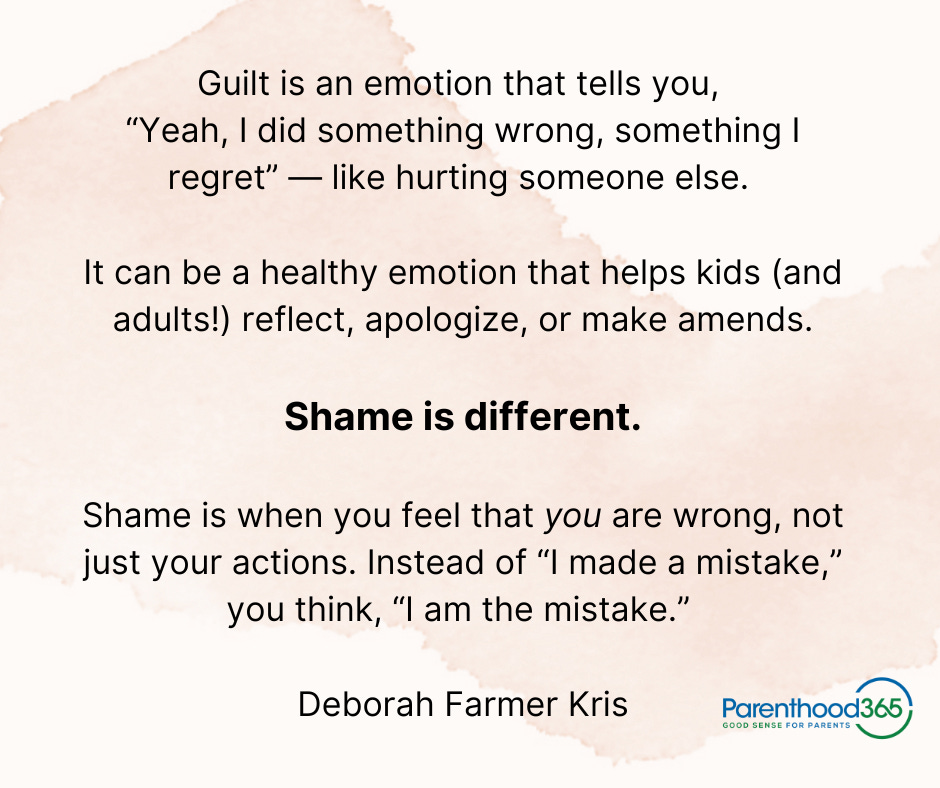What's the difference between shame and guilt?
When it comes to helping kids grow, the distinction is important
Guilt and shame seem synonymous. Both emotions relate to how we feel when we do something wrong, right?
By now, you probably know I love the term “emotional granularity.” Coined by neuroscientist Lisa Feldman Barrett, emotional granularity is the ability to name what we are feeling with a high degree of precision and specificity. Are you enraged or annoyed? Ecstatic or content? Jealous or lonely?
According to Barrett’s research, when we can find the right words to label our emotions, we are better equipped to make good choices.
So What’s the Difference Between Guilt and Shame?
Guilt is an emotion that tells you, “Yeah, I did something wrong, something I regret” — like hurting someone else. It can be a healthy emotion that helps kids (and adults!) reflect, apologize, or make amends.
For example, if your child gets frustrated and kicks the dog, they may feel a flash of guilt because they care about their pet. They didn’t really want to hurt the dog. They were just so mad that it came out like that!
That flash of regret can prompt kids to think about other ways to channel their frustration. Likewise, kids may feel uncomfortable when they break something that matters to a family member. That sense of remorse or guilt can prompt your child to come to tell you what happened and to find a way to make amends.
That’s all worth celebrating — because it takes courage and compassion to notice how your actions affect others, to say you are sorry, and to figure out how to move forward.
Shame is different.
Shame is when you feel that you are wrong, not just your actions. It’s when your kid says to themselves, “I kicked the dog. I’m a terrible person.” Instead of “I made a mistake,” their emotional state says, “I am the mistake.”
I think Brene Brown’s definition of shame is helpful: "I define shame as the intensely painful feeling or experience of believing that we are flawed and therefore unworthy of love and belonging."
This distinction is particularly helpful in parenting because we want to separate the child’s behavior from their sense of self.
This is the explicit message behind my picture book “I Love You All the Time”: Children need to know that they are loved and lovable all the time…
…even when they are angry,
…even when they have meltdowns,
…even when they say things that hurt our feelings.
That doesn’t mean we don’t draw limits, but those limits should be clear and focused on the behavior, not the worth of the child.
If we say to our kids, “I can’t believe you kicked the dog! How could you do such a horrible, mean thing?” — well, kids will often interpret that as “I am a horrible, mean person.” Likewise, if we punish, shame, or mock kids for expressing anger, fear, or disappointment, we send a message that only certain parts of themselves are lovable. We want to help them make good choices, but shaming is never the answer.
Our job is to coach and teach, not shame and blame.
Help kids concretely connect the dots between their actions and other people’s feelings: “When you call your little brother names, it hurts his feelings. I know you get frustrated with him, so let’s brainstorm other ways to handle that feeling.”
Self-Shaming: The Parent Trap
Sometimes, all this can be extra hard if we experienced shame-based discipline growing up. Somtimes, we need to remind ourselves that just because we yelled at our kids this morning, we aren’t bad parents. We are human. We can apologize. We can reconnect.
Is this a good place to mention one of my favorite parenting books? Carla Naumberg’s You Are Not a Sh*tty Parent: How to Exercise Self-Compassion and Give Yourself a Break is a really good one if you tend to self-shame. No judgment. Just compassion. Because we all make mistakes — and we are still loved and loveable, just like our kids.
Best,
Deborah Farmer Kris
www.parenthood365.com





Such wise words!